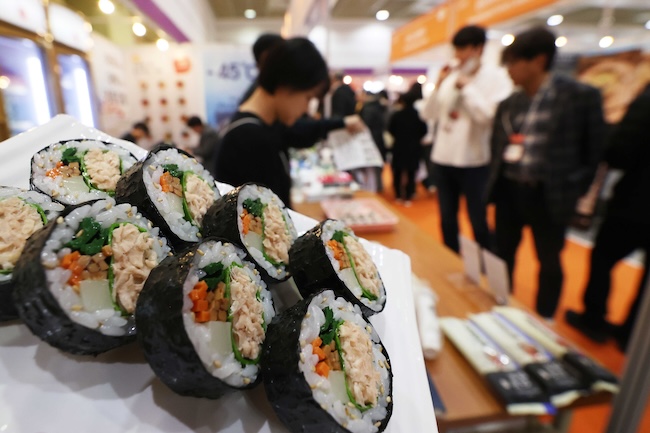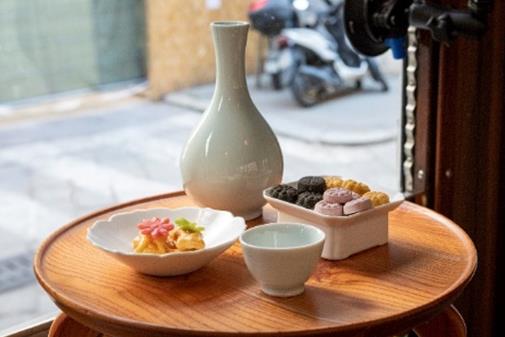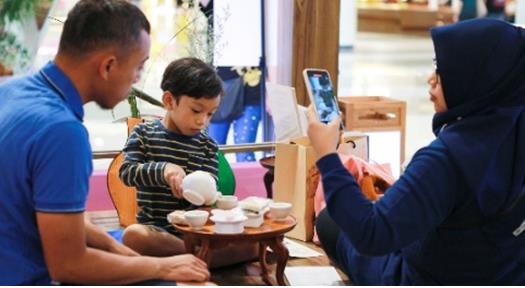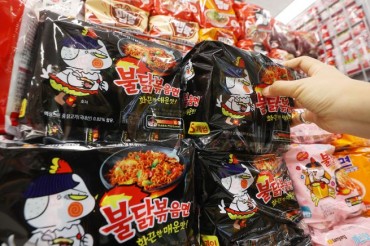
A major U.S. retail chain achieved unprecedented success with its sale of frozen gimbap, to the extent of causing shortages across the United States. (Image courtesy of Yonhap)
SEOUL, Nov. 28 (Korea Bizwire) – Recently, a major U.S. retail chain achieved unprecedented success with its sale of frozen gimbap, to the extent of causing shortages across the United States. While taste, convenience, and health benefits are primary factors for this success, industry analysts say that scenes of characters enjoying gimbap in popular Korean dramas such as ‘Extraordinary Attorney Woo’ and ‘The Glory’ also played a significant role.
The rising popularity of K-culture has seamlessly translated into heightened global interest in Korean cuisine, prompting the government to take a more proactive stance in popularizing Korean food worldwide.
The Korea Craft and Design Foundation (KCDF), which operates under the Ministry of Culture, Sports and Tourism, has been conducting a promotional campaign for Korean cuisine since 2021. This year, the KCDF launched the ‘Hansik: That’s Soban’ campaign, specifically targeting millennials and Gen Zers.
As part of the campaign, the KCDF introduced a variety of Korean traditional table settings, focusing on snacks and beverages rather than traditional dishes such as bibimbap. In April this year, during Milan Design Week, the KCDF unveiled a ‘Korean Tram’ pop-up store that traveled throughout Milan. The tram, adorned with traditional Korean patterns, introduced passengers to traditional table settings like hojokban and najuban, along with various snacks like daesik, maejakgwa, and gaeseong yakgwa.

The tram, adorned with traditional Korean patterns, introduced passengers to traditional table settings like hojokban and najuban, along with various snacks like daesik, maejakgwa, and gaeseong yakgwa. (Image courtesy of Korea Craft & Design Foundation)
Last September, a Korean food culture pop-up store In Jakarta, a key center for Hallyu in Southeast Asia, conducted a snack experience program. Accompanying this were experiential activities such as a traditional culture photo zone, making mini table settings, and crafting herbal tea bags, providing a blend of historical and contemporary content.
This shift in interest from traditional Korean food to broader aspects of K-food culture is a direct result of the rapid dissemination of content through social media platforms. What becomes popular in Korea is quickly trending overseas, influencing global culinary preferences.
An exemplary case is yakgwa, a traditional Korean sweet, which gained popularity through historical dramas like ‘The Red Sleeve.’ According to Shopee Korea, the largest e-commerce platform in Southeast Asia, orders for K-retro snacks, including yakgwa, increased by 53 percent in the first half of this year compared to the same period last year, with orders for yakgwa experiencing a remarkable 450 percent surge.
The KCDF reported positive reactions from locals during the Jakarta event, where attendees could taste yakgwa similar to that featured in the popular drama ‘Love in the Moonlight.’

Last September, a Korean food culture pop-up store In Jakarta, a key center for Hallyu in Southeast Asia, conducted a snack experience program. (Image courtesy of Korea Craft & Design Foundation)
Moreover, according to customs data, ramyeon exports have increased by 24.7 percent compared to the same period last year, reaching a total of $785 million by October this year, surpassing the 1 trillion won mark at current exchange rates.
According to the ’2023 Overseas Hallyu Survey,’ food ranks as the most popular category among Korean cultural content, followed by beauty, music, fashion, movies, and TV dramas. The KCDF highlighted that food not only serves as a standalone category but also benefits from the underlying popularity of other cultural content, making it a domain where favorable experiences are easily translatable.
In particular, the ability of Korean food to capture attention in media content lies in the context within which it appears and the understanding and empathy towards specific situations. Consequently, there is a need for storytelling that effectively communicates the meaning and cultural charm embedded in Korean food, including meal etiquette, culinary philosophy, geographical and historical backgrounds, and the emotional aspects of Koreans surrounding food.
Kim Tae-wan, the head of the Traditional Life Culture Department at the KCDF, stated, “While considering the cultural consumption patterns unique to the countries where campaigns are conducted, we will continue to plan and operate various programs to effectively convey the meaning and cultural charm of Korean food.”
Ashley Song (ashley@koreabizwire.com)






